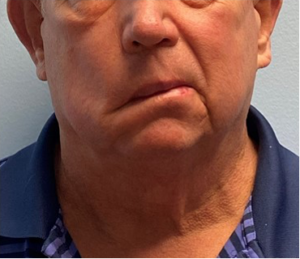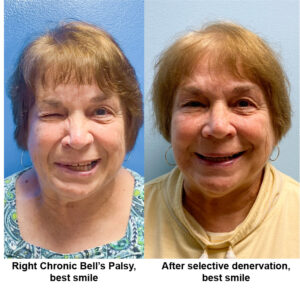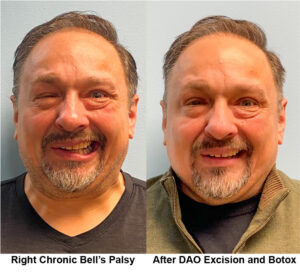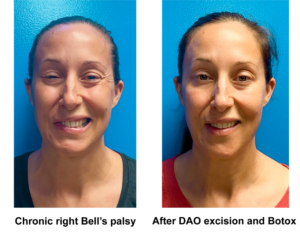Bell’s Palsy
What is Bell’s Palsy?
Bell’s palsy is the most common cause of facial paralysis, first described by Sir Charles Bell in 1821. One in 60 people will experience Bell’s palsy during their lifetime. While 70% of patients make a complete recovery from Bell’s palsy, 30% of people do not fully recover and develop chronic facial asymmetry, facial tightness, synkinesis, and other symptoms of chronic Bell’s palsy.
Bell’s palsy during their lifetime. While 70% of patients make a complete recovery from Bell’s palsy, 30% of people do not fully recover and develop chronic facial asymmetry, facial tightness, synkinesis, and other symptoms of chronic Bell’s palsy.
Bell’s palsy is caused by reactivation of the herpes virus within the facial nerve. This virus reactivation leads to swelling of the facial nerve. The swollen facial nerve becomes compressed by the temporal bone (the bone on which the ear sits) and the nerve fibers suddenly stop working. This sudden damage to the facial nerve leads to the common presenting symptoms of Bell’s palsy:
- Sudden facial paralysis (occurs within 1-3 days of onset)
- Taste changes
- Sensitivity to loud noises
- Discomfort in the ear and area around the ear
- Speech difficulty
- Drooling
- Spilling liquids out of the corner of the mouth
Patients with suspected Bell’s palsy should be evaluated by a healthcare provider immediately. The provider will perform a complete neurologic exam and may perform blood tests and imaging studies to rule out other causes of facial paralysis. If the facial paralysis is complete, an electromyography (EMG) or electroneurography (ENoG) study may be performed to quantify how much facial nerve damage is present. If the diagnosis is confirmed to be Bell’s palsy, patients will typically be prescribed high-dose steroids (e.g., Prednisone) and an antiviral (e.g., Valtrex). It is very important patients with acute Bell’s palsy protect their eyes using eye drops, eye ointment, and eye taping. These eye care precautions improve comfort of the eye and protect its surface.
Recovery from Bell’s Palsy
Since the facial nerve remains intact, patients with Bell’s palsy will improve as the nerve fibers regenerate. This improvement can occur within a few days of paralysis onset, or it can take a few months to occur. This unpredictability can be very difficult for patients, and it is normal to feel disheartened and sad during the recovery process. Patients typically experience an improvement in facial tone (i.e., resting symmetry) and then will begin to see facial movements return. Many times, the regenerating facial nerve establishes proper connections with the facial muscles and the recovery is complete. However, sometimes the facial nerve makes abnormal connections with facial muscles as it regenerates (aka aberrant nerve regeneration), which results in long-term sequelae of Bell’s palsy:
- Facial asymmetry
- Smile asymmetry
- Facial synkinesis: Involuntary facial movements such as eye closing with smile
- Narrowing of the eye
- Facial tightness
- Neck tightness
- Deep nasolabial fold (aka smile lines)
- Chin dimpling
- Platysma banding
Bell’s Palsy Treatments
Many patients with Bell’s palsy have been told there is nothing that can be done to improve their smile, facial asymmetry, eye narrowing, and other long-term manifestations. This is NOT true! There are many treatments that can improve facial symmetry and function in patients with Bell’s palsy:
- Selective denervation
- DAO Excision
- DLI Excision
- Asymmetric facelift
- Botox for facial paralysis
- Filler for facial paralysis
- Targeted facial physical therapy



Consultation at the UNC Facial Nerve Center
Dr. Miller is an expert at evaluating and treating patients with Bell’s palsy. As both a facial paralysis surgeon and a facial paralysis patient, he understands how difficult it can be for patients to cope with their facial paralysis. As an expert in evaluating and treating patients with Bell’s palsy, Dr. Miller will ensure the correct diagnosis is made and work with patients to develop a personalized treatment plan. He understands each Bell’s palsy patient is unique and treatment should be customized to the patient. Dr. Miller is happy to see you for a consultation visit, whether you have just been diagnosed or have lived with Bell’s palsy for years!
To schedule a consultation visit, please call 984-974-2255.